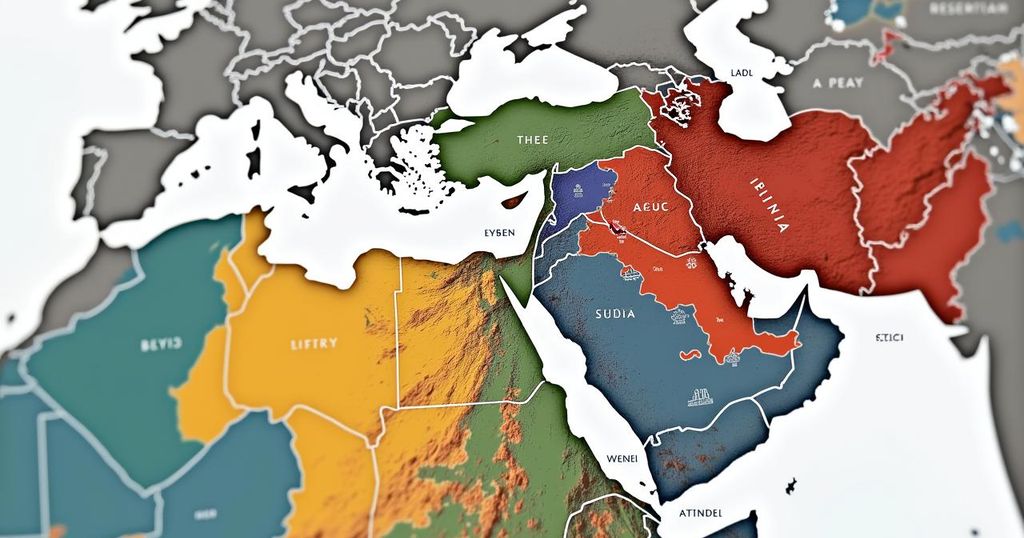During his address at the United Nations General Assembly, Israeli Prime Minister Benjamin Netanyahu showcased two maps to illustrate Middle Eastern alliances and threats, notably excluding Palestine from both. He linked the ongoing regional violence to Iranian influence and stated that Israel was compelled to defend itself against such threats. The maps included nations signaling collaboration with Israel, notably Egypt, Sudan, Saudi Arabia, and India, further complicating the Israeli-Palestinian conflict and regional diplomacy amidst rising tensions with Iran.
Israeli Prime Minister Benjamin Netanyahu, during his address at the United Nations General Assembly in New York, displayed two maps to emphasize his perspective on Middle Eastern geopolitics. In his right hand, he held a map labeled “The Curse,” illustrating a region dominated by nations such as Iran, Iraq, Syria, and Yemen, shaded black. Conversely, his left hand displayed a map identified as “The Blessing,” showing countries like Egypt, Sudan, Saudi Arabia, and even India in green, signaling potential or established alliances with Israel. Notably, the absence of Palestine was striking in both maps, as the area was omitted entirely from any representation. Netanyahu attributed the ongoing disturbances in the region, particularly the escalating violence in Lebanon, Syria, and Yemen, directly to Iranian influence and support of militant groups such as Hezbollah and Hamas, positing Israel’s military responses as essential defenses against these threats. While discussing the countries depicted in green, Netanyahu indicated a vision of alliances with nations that had either normalized relations with Israel or were in negotiations to do so. However, the contentious nature of relationships was highlighted, particularly with Saudi Arabia, which has asserted that normalization with Israel hinges on the establishment of a Palestinian state. The ongoing conflict between Hamas and Israel has further complicated prospects for any diplomatic progress. The map’s inclusion of Egypt, a long-standing but complicated ally since the 1979 peace treaty, underscores the necessity of maintaining regional stability, especially concerning Gaza. Sudan’s alignment with Israel has evolved since its signing of the Abraham Accords in 2021, transitioning from hostility to cooperation. Lastly, India’s placement on the map reflects a growing relationship between New Delhi and Tel Aviv, particularly in defense and technology, despite India’s historical support for Palestinian self-determination. In his address, Netanyahu firmly stated, “If you strike us, we will strike you,” reinforcing Israel’s readiness to respond decisively to threats, while some diplomats chose to walk out in protest of his remarks. Overall, Netanyahu’s address and the maps presented serve not only to delineate perceived threats and allies in the region but also to highlight the enduring complexities of Middle Eastern diplomacy.
The speech and presentation of the maps by Israeli Prime Minister Benjamin Netanyahu at the United Nations General Assembly reflect significant geopolitical dynamics in the Middle East. As regional tensions escalate due to Iranian influence, Netanyahu’s portrayal of countries in relation to Israel can provide insight into current and potential alliances. The omission of Palestine from these maps is particularly provocative and highlights Israel’s position in ongoing disputes over Palestinian statehood and rights. Understanding the backdrop of alliances, particularly with nations like Saudi Arabia, Egypt, and India, alongside ongoing hostilities with groups like Hamas and Hezbollah, is critical to comprehending contemporary Middle Eastern politics and the challenges in navigating diplomacy in this volatile region.
In conclusion, Prime Minister Netanyahu’s address at the UN, coupled with his presentation of two distinctly mapped perspectives of the Middle East, underscores the complex interplay of alliances and threats within the region. The complete absence of Palestine in these depictions suggests a continued neglect of its status in international discourse. The highlighted relations with countries such as Saudi Arabia, Egypt, Sudan, and India reveal ongoing diplomatic efforts and the intricate balancing act of regional politics. As tensions with Iran and its proxies persist, the calls for military readiness reflect Israel’s precarious position within a dangerous geopolitical landscape.
Original Source: www.ndtv.com






